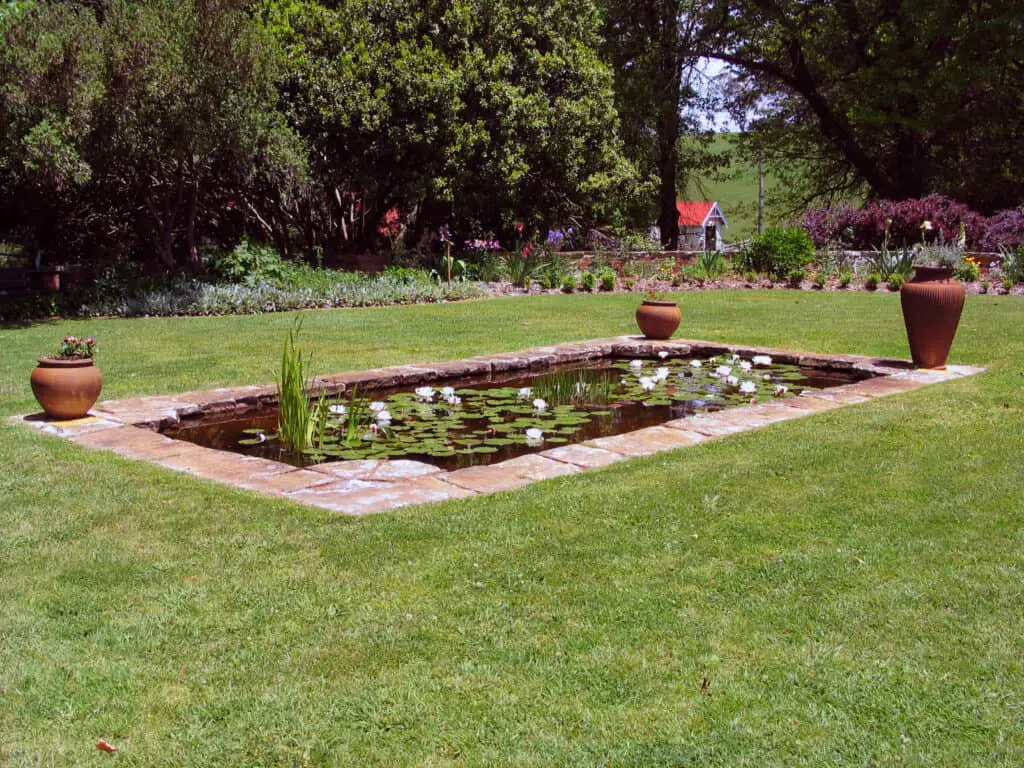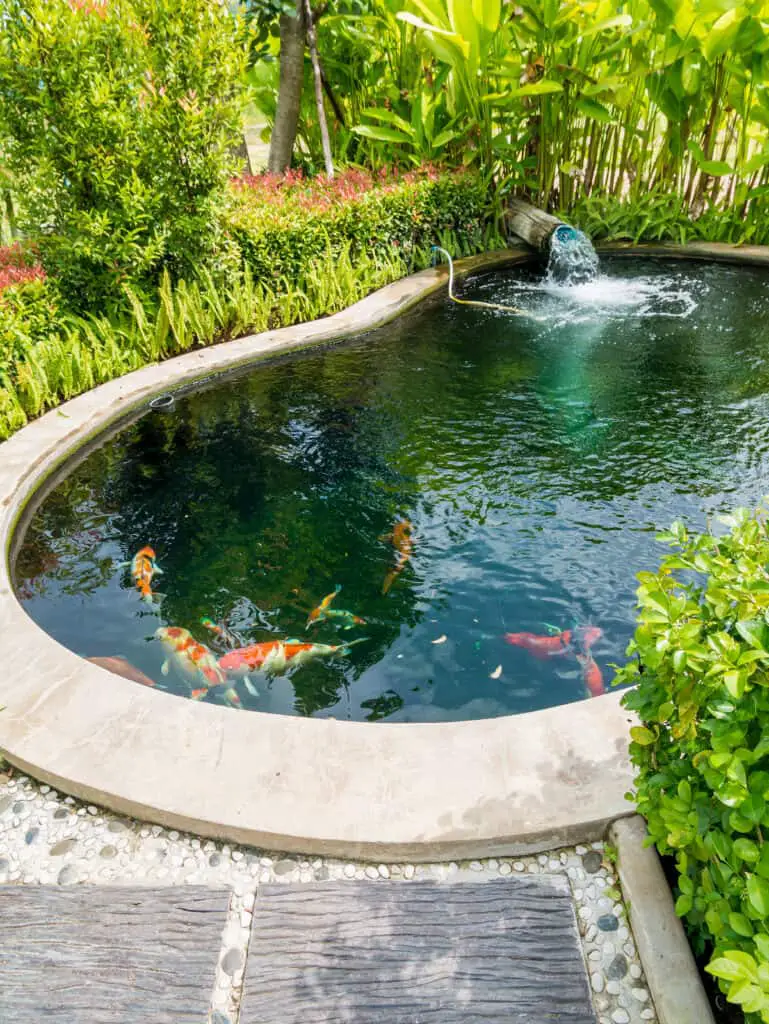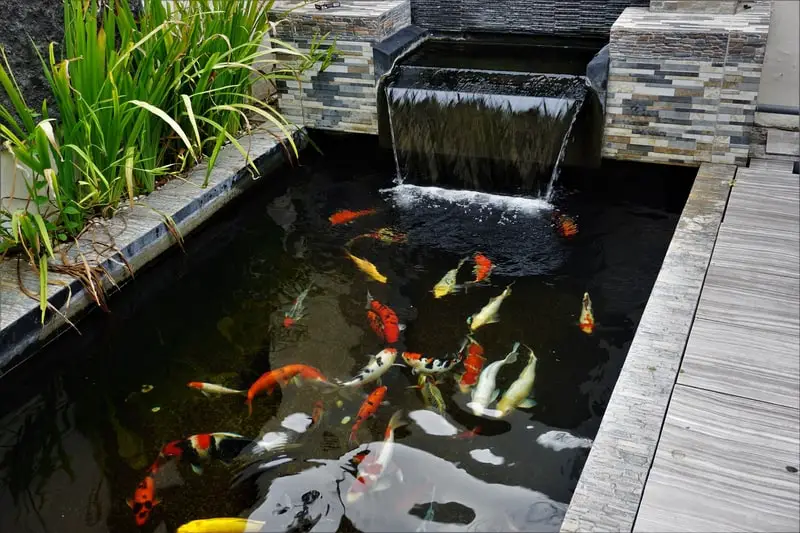
The shape of a koi pond is vital to the health and survival of your fish and determines how much daily work you have to put into it. Winding ponds with many curves may seem wonderful in theory, but in practice contain all kinds of traps for “dead” water and accumulate leaves and debris. Total water circulation around and within the pond is crucial to keeping koi healthy.
The best shape for a koi pond is a simple rectangle or curvilinear shape like an oval, big enough for the fish to get enough exercise. Sharp angles and narrow channels impede water circulation and allow fish waste and harmful bacteria to accumulate. Maintenance is manageable with simple shapes.
There are pond shapes that will require hours of backbreaking maintenance work and multiple pumps and filters at different points to ensure proper water circulation. Then there are others that will save you time, effort, and money because they are more efficient. This article looks at a koi pond’s most practical and aesthetically pleasing shape.
Pro Tip: If you’re tired of wasting money and making costly mistakes on the koi-keeping hobby or are thinking about buying koi fish but don’t know where to start, I strongly suggest you check out this ebook. I recently read this ebook, and it contains SO much useful information, such as:
- 3 proven steps to identify koi fish diseases
- WARNING: 3 things you should NEVER do when it comes to caring for koi
- When to seek professional help when it comes to looking after your koi
Best Shape For The Outer Contours Of A Koi Pond

If you’re into feng shui, rounded shapes are more natural than shapes with angles, but this doesn’t mean that you are confined to a circle. You can use ovals or parabolas or slightly scalloped, graceful freeform curves. The main thing is that the walls inside the pond allow for the free circulation of water.
Simple rectangles can be appealing to the minimalist and in keeping with Japanese simplicity of form, yet still very beautiful. The best shape for water quality is one with rounded corners, so even if you have a rectangular pond, the corners should be rounded off below the surface. Too many corners around the outside can hide koi from view, preventing the display of their glorious colors.
If the water cannot circulate freely in all parts of the pond due to angles and corners, harmful bacteria can accumulate in and colonize these areas. Complex shapes make the construction of a koi pond more difficult and mean more folds in pond liners that can trap debris and waste.
Best Shape For the Inner Walls Of A Koi Pond
The best shape for the inner walls of a koi pond below the surface is one that doesn’t impede the flow of water. Generally, the inside walls should drop straight down to the desired depths, and corners must be rounded. A koi pond is not just another water feature. It is a habitat for koi, so it must be designed to meet their needs.
Koi are high maintenance, and the pond must be regularly cleaned, so choose a shape that allows easy maintenance. The pond must not be too narrow or shallow for the fish to swim in, so narrow channels between different pond areas should be avoided. Sharp edges on the inner walls can damage their skin if they scrape along them.
You should always bear fish maintenance in mind when choosing a profile for your koi pond to be as quick and easy as possible. You may occasionally catch your koi to check for parasites and diseases. If your pond shape is too broad or complex, getting hold of them may prove difficult.
Koi Ponds Should Fit In With Their Surroundings

A pond is usually a key feature in any landscape, so you should shape it to compliment the surrounding area. It would be best if you chose a pond shape that is in keeping with the feel of your garden. A more formal rectangle or square-shaped pond won’t look out of place if you have a highly geometrical, regimented garden with rectangular, formal flower beds and neatly squared-off shrubs.
A raised or above-ground pond incorporating a natural stone wall can be lovely in geometrical shapes that fit neatly onto a small property. However, if your garden is full of curving flower beds, winding paths, and tangled shrubs, it would be better to have a gently curved pond that appears more natural in its surroundings.
The shape may also vary depending on whether you want a waterfall. Waterfalls take up space, increase water evaporation, and look better in naturally-shaped curvy ponds than in rectilinear ones. However, it is possible to have a waterfall in a geometrically shaped pond if thoughtfully designed.
When designing a Koi pond, it’s best to stick to simple symmetrical shapes incorporating long straight lines or curves with as few angles as possible. After all, the object is to enjoy the splendor of the koi, rather than just having a water feature. Koi are best viewed from above because of their stunning dorsal patterns, so you should be able to comfortably walk around the pond to see them from the edges.
Of course, size and shape go together. Some say the best size for a koi pond is twenty-five feet long by thirteen feet wide with a maximum depth of three feet. The contours don’t have to be straight lines, but the general size of the pond should not be smaller than these dimensions for the koi to thrive. They need space to swim freely horizontally and vertically in the water.
Koi are less resilient than goldfish and may struggle in a pond where the latter thrive. They can become stressed in cramped conditions where they can’t get enough exercise. Complex shapes with nooks and crannies are harder to keep clean and may prevent koi from swimming freely.
Shade is vital to koi, so you need to factor this into the shape of the pond. For example, you may want to install a shade structure or some aquatic plants at one end or plant shade-producing shrubs around some of the edges. This will also affect the shape you choose for the pond.
Best Shape For The Bottom Of A Koi Pond
You might think that a flat bottom is ideal for a koi pond, but it requires almost constant vacuuming over the entire surface. The reason is that leaves, fish waste, and debris will settle evenly across the bottom where they fall, meaning there is a greater surface area on which they can accumulate.
If the bottom of the pond is sloped, debris will accumulate at the deepest end, where it can more easily be vacuumed, filtered, or scooped out. The drains should also be located in the deepest end of the pond, where the water will reach it as it flows downwards. Bottom drains with gravity feeds to the filtration system allow you to purge the sediment of harmful anaerobic bacteria and chemicals from koi feces that build up over time.
A sloped bottom allows for better water circulation and oxygenation and eliminates dead spots. The pond must be deep enough to shield the koi from direct sunlight and prevent the water from overheating.
It is usually necessary to remove a certain amount of water and replace it once or twice a week, so the shape of the bottom of the pond must facilitate drainage. There shouldn’t be scoops or hollows on the bottom of the pond.
Conclusion
The best shape for a koi pond is simple, symmetrical, rectilinear, or curvilinear without sharp corners and angles on the inner walls. The outer contours can have corners and angles, provided the inside is smooth and rounded, allowing water to circulate freely. The bottom of the pond must be a smooth downward slope to facilitate drainage, and gravity feeds into the filtration system.
References:
https://www.thespruce.com/koi-pond-design-ideas-5120003
https://feng-shui.lovetoknow.com/feng-shui-tips/designing-feng-shui-koi-fish-pond
https://www.tfhmagazine.com/articles/freshwater/building-and-maintaining-a-koi-pond-full-article

